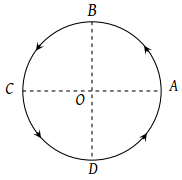A stone tied to the end of a string of \(1\) m long is whirled in a horizontal circle with a constant speed. If the stone makes \(22\) revolutions in \(44\) s, what is the magnitude and direction of acceleration of the stone?
1.
\(\dfrac{\pi^2}{4}\) ms–2 and direction along the radius towards the center
2.
\(\pi^2\) ms–2 and direction along the radius away from the center
3.
\(\pi^2 \) ms–2 and direction along the radius towards the center
4.
\(\pi^2\) ms 2 and direction along the tangent to the circle
If the equation for the displacement of a particle moving on a circular path is given by \(\theta = 2t^3 + 0.5\) where \(\theta\) is in radians and \(t\) in seconds, then the angular velocity of the particle after \(2\) sec from its start is:
1. \(8\) rad/sec
2. \(12\) rad/sec
3. \(24\) rad/sec
4. \(36\) rad/sec
For a particle in a non-uniform accelerated circular motion
1. Velocity is radial and acceleration is transverse only
2. Velocity is transverse and acceleration is radial only
3. Velocity is radial and acceleration has both radial and transverse components
4. Velocity is transverse and acceleration has both radial and transverse components
The coordinates of a moving particle at any time \(t\) are given by \(x= \alpha t^3\) and \(y = \beta t^3.\) The speed of the particle at a time \(t\) is given by:
| 1. | \(\sqrt{\alpha^{2} + \beta^{2}}\) | 2. | \(3t \sqrt{\alpha^{2} + \beta^{2}}\) |
| 3. | \(3t^{2} \sqrt{\alpha^{2} +\beta^{2}}\) | 4. | \(t^{2} \sqrt{\alpha^{2} +\beta^{2}}\) |
The figure shows a body of mass m moving with a uniform speed v along a circle of radius r. The change in velocity in going from A to B is:
1.
2.
3. v
4. zero
A particle moves in a circular path with decreasing speed. Choose the correct statement.
(1) Angular momentum remains constant
(2) Acceleration () is towards the center
(3) Particle moves in a spiral path with decreasing radius
(4) The direction of angular momentum remains constant
The angle turned by a body undergoing circular motion depends on time as . Then the angular acceleration of the body is
(1) θ1
(2) θ2
(3) 2θ1
(4) 2θ2
A stone is just released from the window of a train moving along a horizontal straight track. The stone will hit the ground following
(1) Straight path
(2) Circular path
(3) Parabolic path
(4) Hyperbolic path
An aeroplane is flying at a constant horizontal velocity of 600 km/hr at an elevation of 6 km towards a point directly above the target on the earth's surface. At an appropriate time, the pilot releases a ball so that it strikes the target at the earth. The ball will appear to be falling
(1) On a parabolic path as seen by pilot in the plane
(2) Vertically along a straight path as seen by an observer on the ground near the target
(3) On a parabolic path as seen by an observer on the ground near the target
(4) On a zig-zag path as seen by pilot in the plane
A bomb is dropped from an aeroplane moving horizontally at constant speed. When air resistance is taken into consideration, the bomb
(1) Falls to earth exactly below the aeroplane
(2) Fall to earth behind the aeroplane
(3) Falls to earth ahead of the aeroplane
(4) Flies with the aeroplane







